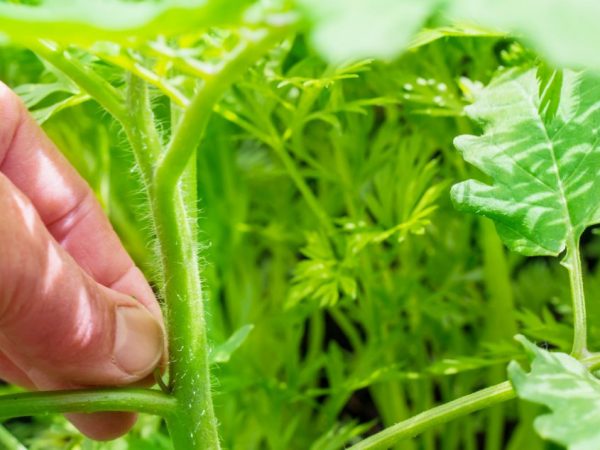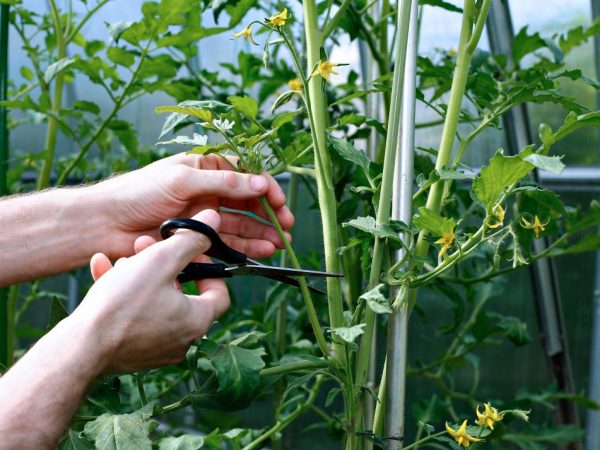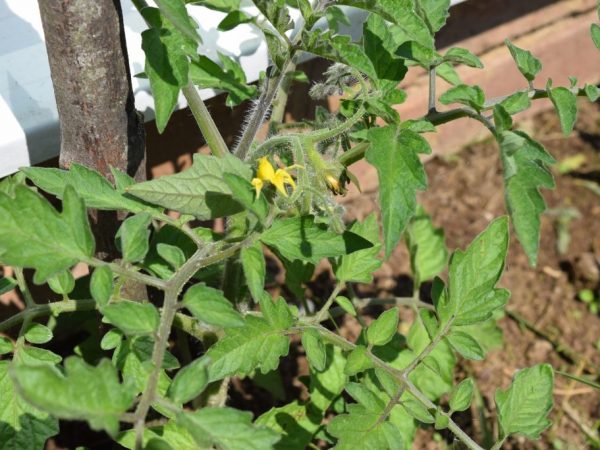How to pinch tomatoes correctly
Anyone who grows crops in a vegetable garden or in a greenhouse wants to achieve the maximum yield. As for the cultivation of a crop such as a tomato, an effective tool that helps to get a good harvest of tomatoes is garter and pinching, especially the use of stepchildren in greenhouse growing conditions.
- What is pinning
- How not to confuse a stepson with a sheet
- What time is the pinching
- The nuances of pinching
- Correct pinching technique
- Forming one stem
- Bush with two stems
- How to form a three-stem bush
- How the process changes depending on the type of tomato
- Indeterminate type
- Semi-determinant tomato type
- Features of determinant varieties

Tomato pinching rules
Today we will learn about what is pinching a tomato, how to pinch tomatoes correctly and how, in fact, to understand what a stepson is and how it differs from an ordinary leaf.
What is pinching
Tomato grazing is the separation of lateral shoots, these shoots grow from deciduous sinuses. Why is this procedure mandatory? Indeed, it is imperative to pinch a tomato, the fact is that the stepchildren steal the vitality of the plant, which negatively affects the growth of the shrub, and also worsens the yield indicators.
For a better understanding of the process, it is worth identifying goals, for which it is recommended to carry out pinching:
- With the help of this process, you can easily independently perform the formation of the required number of stems.
- You can speed up your tomato harvest
- There is a real opportunity to extend the fruiting period of tomatoes
- The yield will increase in quantitative terms, so it will be possible to get more fruits from one tomato bush.
How not to confuse a stepson with a sheet
Novice gardeners and gardeners often confuse an ordinary leaf with a stepson, we will try to shed light on this issue. First of all, carefully examine what the tomato bush looks like. Leaves grow on the stem of a tomato bush, and in the axils of these leaves there is an shoot, which is usually called a stepson. Such a neoplasm grows quite quickly, its leaves develop rapidly, thereby giving rise to the same stepchildren, but already of the second level.
It is worth saying that all stepchildren are subject to removal and pruning, and this must be done before they have grown too much. It is extremely important to do this for the reason that such processes suck out the strength of the bush, thus, future fruits do not receive nutrients, and the bush itself does not grow. It is important to get rid of such processes carefully enough so as not to damage the stem, thereby not causing even more damage to the bush.
What time is the pinching
Many people wonder when it is correct to carry out the pinching procedure, when to cut and remove the processes.Here the answer will be extremely simple, it is carried out as needed, that is, throughout the entire life cycle of a tomato bush, starting with the fact that the bush needs to be rooted. However, it can be noted that the stepsons appear exactly then the bush enters the flowering stage.
It is important to say that in advanced cases, when tomatoes were not pinched for a long time, regardless of the variety, the removal of the shoots is much more difficult. The fact is that they grow so much that it is practically impossible to make out which leaves are true and which are pests. The only advice that can be taken is the characteristic location of the stepson, usually it is located just below the flower brush.
There is one more advice from experienced gardeners, the most suitable time for the procedure is morning, since it is at this time of the day that the stepsons break off most easily. It should also be said that by the end of the day, the crack on the stem will completely heal. If it was not possible to work on the beds in the morning, then all the wounds on the stem must be treated with ash.
If there are bushes in the greenhouse that cause concern, for example, the foliage on a piece is yellow and not elastic. It is recommended to leave such tomato bushes for one day without treatment in order to check if the plant is infected with parasites or if it is a lack of care. This is to prevent further spread of the disease.
The nuances of pinching

Remove hatching buds promptly
It so happens that after the removal of the shoot from the bud, a new stepson begins to hatch in the same place, which poses a threat to the culture. The reason for this phenomenon may be excessive watering or too abundant feeding. Of course, after pinching, you should immediately reconsider caring for tomatoes. Usually, to avoid such situations in the future, it is necessary to carefully and carefully examine the entire bush so as not to miss a single bud.
There are situations when the stepson sprouts directly from the flower, which looks like a common continuation of the inflorescence. They are also subject to removal, as they call into question the harvest.
In addition to the fact that the stepsons must be removed, it is also necessary to tear off all the lower leaves from the shrub, this must be done strictly in late spring - early summer, when it is not yet so hot outside. This process has its own recommendations, the sheets should be torn off gradually, no more than three a day. If done aggressively, there is a chance of crop loss. In addition, the technology must be observed - the leaves should be removed not sideways, but towards the ground, that is, down.
Correct pinching technique
Before talking about how pinching is carried out correctly, it is worth identifying some scheme of the process, such as:
- The procedure is carried out at least once a week.
- It is necessary to determine in advance how many stems there will be in the bush. Earlier we talked about the fact that the number can vary, from one to three stems. Next, we will look at how these techniques differ.
Forming one stem
It is worth saying that experienced farmers claim that the single-stem version is most suitable for growing tomatoes in greenhouses. However, those who grow tomatoes at home say the opposite, claiming that growing stems has a positive effect on increasing yields. We will find out how the formation of one stem is performed.
To form a bush with one stem, you need to break off all the stepchildren, including those stepsons who formed in the area of the bifurcation of the stem. However, it is important to leave the color brushes intact, including the one at the very bottom.
Bush with two stems
To form a two-stemmed plant from a tomato bush, it is necessary to leave the first stepson intact, usually it is quite powerful and developed, so it is not difficult to find it.
If you still have problems with its detection, you need to find the most developed flower branch, the stepson you are interested in is located under it. All other stepchildren of tomatoes must be removed. It is worth saying that cherry tomatoes are often formed into two stems, such a formation turns out to be the most appropriate.
How to form a three-stem bush

When forming, follow the recommendations
To get three stems on a tomato bush at once, you need to perform the following steps step by step:
- As in the previous version, we leave the very first stepson located at the base of the flower brush.
- Next, you need to find another well-developed stepson, his usual location is the area under the first process
- The rest of the stepsons must be carefully removed by breaking down.
How the process changes depending on the type of tomato
It is worth saying that tomatoes are divided into three groups, depending on what the pinching scheme changes:
- Determinant varieties
- Indeterminate
- Semi-determinant varieties
Let's move on to a description of each of the three types, and learn how to properly remove stepchildren, depending on which culture belongs to one type or another.
Indeterminate type
This group includes tomatoes that do not have restrictions in terms of growth, usually a single-stem formation of a bush is chosen for them. This choice can be explained by the fact that such bushes usually create a large number of shoots on the side.
The peculiarity of pinching of this variety can be called the fact that a stump should form at the place of separation of the stepson, the height of which will be approximately equal to 1 centimeter. Such, for a normal harvest, you need to get rid of all flower buds, except for the most developed ones, it is recommended to leave no more than 10 pieces.
Semi-determinant tomato type
This tall tomato variety grows to a record 190 cm. Depending on how densely and densely the seedlings are planted, you can form a plant in 2 or 3 stems. In such standard bushes, the problem is quite often that the stem can stop growing, that is, the growth ends with an inch and comes to naught. To prevent this from happening, do not rush to pinch, you need to make sure that the plant does not tip, that is, the stem continues to grow moderately.
However, even if rooting has occurred, there is no need to worry, this is a fixable situation. In such cases, it is recommended to form a tall shrub with 2 or 3 stems, it will not be difficult to grow such a bush.
Features of determinant varieties
It is customary to include here those varieties that are not distinguished by high growth, they can be found in Siberia. Usually, they do not need frequent pinching, however, you should not completely abandon it. Here it is necessary to adhere to the recommendations given by seed producers, usually they are indicated on the package.
To maximize the yield of such tomatoes, you should follow these rules when leaving:
- The stepsons are removed, but they need to be removed gradually, cutting off no more than 5 pieces at a time
- The inflorescences also need to be removed, only a few are left, no more than 3, no longer required
- It is important to pluck the topmost inflorescence, leave only the growth point in it, this rule is one of the most important to fulfill.
Now you know how to pinch tomatoes correctly, why it is necessary, why it is so important after planting seedlings. Finishing the story about pinching tomatoes, it is worth saying that this process is an integral part of caring for the crop, like the garter, without it it will not be possible to get a good harvest of tomatoes.


